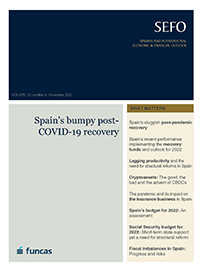Spain’s bumpy post-COVID-19 recovery
Fecha: November 2021
SEFO, Spanish and International Economic & Financial Outlook, V. 10 N.º 6 (November 2021)
Index
[expand title= "Spain’s sluggish post-pandemic recovery"]
Spain’s economic recovery is proving weaker than initially predicted, with 2021 growth now projected to come in 1.2 percentage points lower than in the previous forecast. Inflation will continue to be a key source of risk, with the potential to further undermine household and business purchasing power.
[/expand][expand title= "Spain’s recent performance implementing the recovery funds and outlook for 2022"]
Spain is set to received 140 billion euros as part of the Next Generation EU funds to facilitate the country’s recovery from the COVID-19 crisis, with a focus on the green and digital transitions. So far, progress on executing plans to use these funds has been uneven, with investments and reforms expected to ramp up in 2022.
[/expand][expand title= "Lagging productivity and the need for structural reforms in Spain"]
Spanish productivity has lagged both the US and eurozone for the past two decades due to lower investment in key areas, such as technological and human capital, among others. Although the European recovery funds should facilitate investment in areas like digitalisation, structural reforms will also be necessary to boost Spain’s productivity growth.
[/expand] [expand title= "Cryptoassets: The good, the bad and the advent of CBDCs"]The emergence of cryptoassets provides both risks and opportunities for investors, banks and central banks alike. However, determining the ideal design and regulation of these assets, as well as anticipating any potential risks, will be key to minimizing financial system disruption and maximizing the associated benefits.
[/expand][expand title= "The pandemic and its impact on the insurance business in Spain"]
The impact of the pandemic on the insurance industry was significant, if uneven, across both geographies and business lines. While the industry is showing signs of recovery, forecasts are predicated on the normalisation of claims and the continuation of financial market stability.
[/expand] [expand title= "Spain’s budget for 2022: An assessment"]Spain’s state budget for 2022 includes forecasts that appear markedly optimistic in comparison to other institutions’ estimates. Despite this, an increase in structural spending is likely, which casts doubt on the government’s ability to meet its deficit reduction targets.
[/expand][expand title= "Social Security budget for 2022: Short-term state support yet a need for structural reform"]
Thanks to the increase in contributions, the Social Security deficit is projected to fall to 0.5% in 2022. However, the long-term sustainability of Spain’s Social Security will require action on both the expenditure and revenue side that goes beyond recent initiatives.
[expand title= "Fiscal imbalances in Spain: Progress and risks"]
Spain’s 2020 deficit came in better than expected, with analysts’ projections for 2021 more favourable than current government estimates. That said, risks relating to an ageing society, an entrenched structural deficit, and a permanent increase in spending mean Spain requires a credible fiscal consolidation plan.
[/expand]
